Field Judging Elk
By Jay Scott
©Copyright Elk Hunter Magazine
"Saw a big bull yesterday; figure he was over 400." How many times have your heard that? Did you believe the guy who told you? Did he have a method for coming up with that number, or was it just a guess?
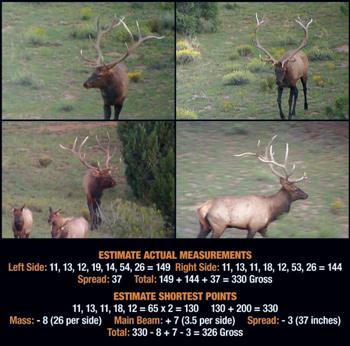
There are several ways to field judge elk; one is to "air judge" - the wing-it approach based on experience and knowledge, and this surely has its place at times. The other is to actually break him down and measure him up by estimating point and beam length, mass, and inside spread. I gained the most consistency and accuracy with my field judging by actually scoring lots of antlers, and with each one, I gained more confidence. I love to field judge bulls and then score them on the ground to see how close my field judging was to the real thing. Oftentimes I score a bull in my head before asking the hunter what it actually scored, but nothing beats getting out a tape and measuring lots of bone. My guesses have been wrong many times, but it's amazing how close you can get from the field estimates to the actual measurements with a little practice.
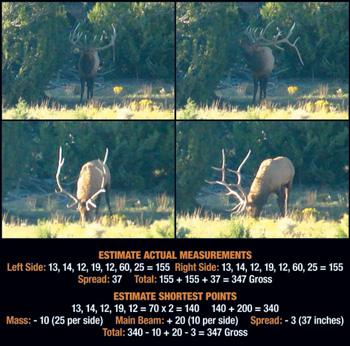
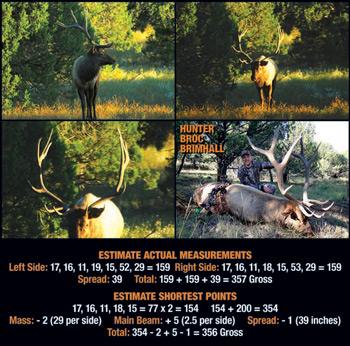
Estimate Actual Measurements
Tines - There are several things I like to do when trying to estimate the actual measurements on a bull elk. First, I use anatomical references to estimate several of the point lengths. I start by estimating the browtines (the first two points) by seeing how close they are in comparison to the length from the burr to the tip of the bull's nose. On a mature bull, that measurement is 15-16 inches. So if the first two points on each side follow parallel with the nose and tip up just at the end of the nose, they should be right around 16 inches. Beware of straight-looking points without much end curve, because they are often shorter than you think. Long browtines will follow the nose and then curl or bend upward (look for at least four inches of curl for a 20-inch tine).
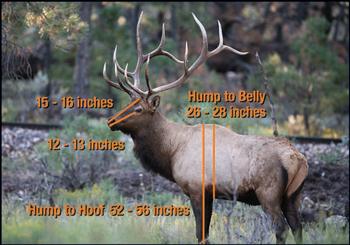
Once I determine the length of the first two points, I then extrapolate those into the rest of the points. The third points are often the source of a bull's weakness; again, look for curl or lots of curve.
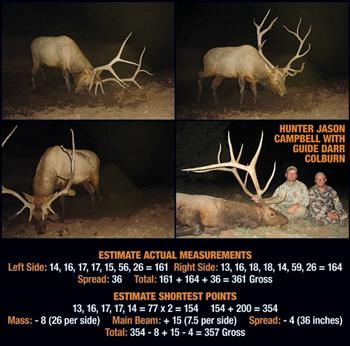
By Jay Scott
©Copyright Elk Hunter Magazine
"Saw a big bull yesterday; figure he was over 400." How many times have your heard that? Did you believe the guy who told you? Did he have a method for coming up with that number, or was it just a guess?

There are several ways to field judge elk; one is to "air judge" - the wing-it approach based on experience and knowledge, and this surely has its place at times. The other is to actually break him down and measure him up by estimating point and beam length, mass, and inside spread. I gained the most consistency and accuracy with my field judging by actually scoring lots of antlers, and with each one, I gained more confidence. I love to field judge bulls and then score them on the ground to see how close my field judging was to the real thing. Oftentimes I score a bull in my head before asking the hunter what it actually scored, but nothing beats getting out a tape and measuring lots of bone. My guesses have been wrong many times, but it's amazing how close you can get from the field estimates to the actual measurements with a little practice.


Estimate Actual Measurements
Tines - There are several things I like to do when trying to estimate the actual measurements on a bull elk. First, I use anatomical references to estimate several of the point lengths. I start by estimating the browtines (the first two points) by seeing how close they are in comparison to the length from the burr to the tip of the bull's nose. On a mature bull, that measurement is 15-16 inches. So if the first two points on each side follow parallel with the nose and tip up just at the end of the nose, they should be right around 16 inches. Beware of straight-looking points without much end curve, because they are often shorter than you think. Long browtines will follow the nose and then curl or bend upward (look for at least four inches of curl for a 20-inch tine).

Once I determine the length of the first two points, I then extrapolate those into the rest of the points. The third points are often the source of a bull's weakness; again, look for curl or lots of curve.


